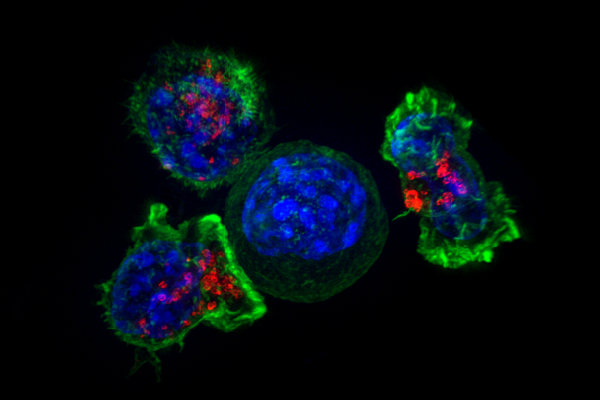Scientists solve major cancer protein conundrum

Despite intense research, there's been much confusion regarding the exact role of a protein in a critical cancer-linked pathway. On one hand, the protein is described as a cell proliferation inhibitor, on the other, a cell proliferation activator, a duality that has caused a great deal of scientific head scratching.
Now scientists from the Florida campus of The Scripps Research Institute (TSRI) have solved the conundrum, uncovering the regulatory machinery underlying the function of a protein, called angiomotin.
The researchers found that angiomotin's activities depend on a process called phosphorylation—when a phosphate group is added to its structure at a specific location. Add a phosphate group, and the protein can inhibit cell proliferation. But remove a phosphate group from its normal makeup, and the protein promotes cell proliferation, encouraging cancer cell growth.
The study, led by Joseph Kissil, associate professor in the Department of Molecular Medicine at TSRI, was recently published in the journal eLife.
Protein's Position in Cells is Key
The new study sheds light on signaling pathway in cells called the Hippo-YAP pathway.
YAP's involvement in cancer has been demonstrated in several tissues, including liver, intestine, heart, pancreas and brain. Recent studies show YAP plays a key role in developing drug resistance in lung and colon cancer cells and promoting cancer in some colon and pancreatic cancers. Hippo regulates cell proliferation and programmed cell death, which often become corrupted in diseases like cancer.
Whether the Hippo-YAP pathway can be altered by the protein angiomotin is not in question. But while some studies give angiomotin a YAP-inhibitory function, others indicate that the protein is required for YAP activity.
Kissil and his colleagues discovered what lies at the heart of those seemingly contradictory reports. They found that YAP forms a complex with angiomotin and another protein called Merlin. When angiomotin is phosphorylated, that changes the localization of this complex to the cell plasma membrane where it prevents cells from proliferating.
"The relocation of the protein complex out of the nucleus to the plasma membrane prevents YAP from operating as a growth-promoting transcriptional activator," explained TSRI Graduate Student Sany Hoxha, co-first author of the study.
Conversely, when angiomotin is less than fully phosphorylated, the complex is localized in the nucleus, where it promotes YAP-dependent cell proliferation.
"Since this is a major pathway for diseases like cancer and fibrosis, our findings add a brand-new layer of valuable information," said Kissil.
More information: Susana Moleirinho et al, Regulation of localization and function of the transcriptional co-activator YAP by angiomotin, eLife (2017). DOI: 10.7554/eLife.23966


















